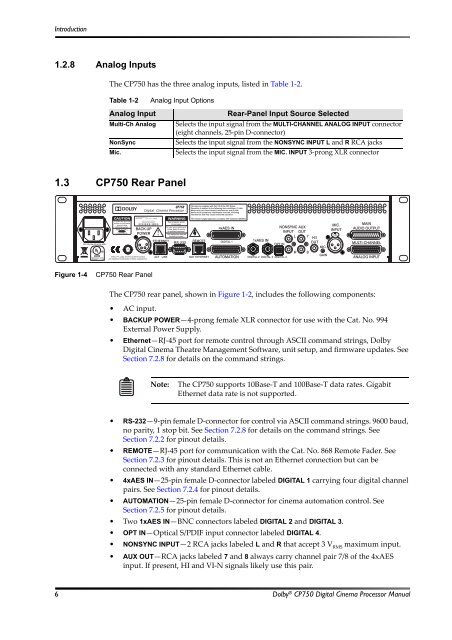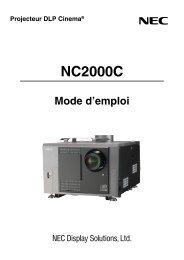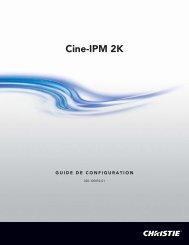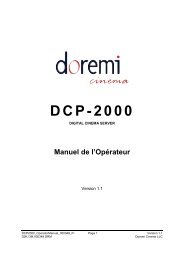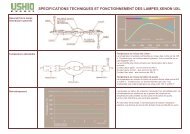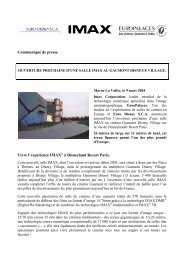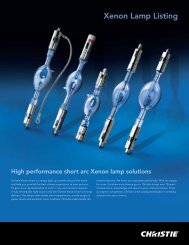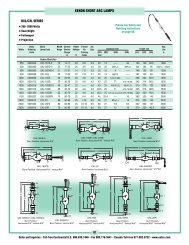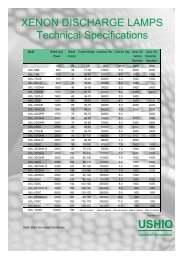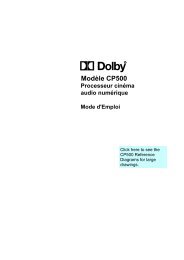Dolby CP750 Digital Cinema Processor Manual - Projectionniste.net
Dolby CP750 Digital Cinema Processor Manual - Projectionniste.net
Dolby CP750 Digital Cinema Processor Manual - Projectionniste.net
You also want an ePaper? Increase the reach of your titles
YUMPU automatically turns print PDFs into web optimized ePapers that Google loves.
Introduction<br />
1.2.8 Analog Inputs<br />
The <strong>CP750</strong> has the three analog inputs, listed in Table 1‐2.<br />
Table 1-2<br />
Analog Input<br />
Multi-Ch Analog<br />
NonSync<br />
Mic.<br />
Analog Input Options<br />
Rear-Panel Input Source Selected<br />
Selects the input signal from the MULTI-CHANNEL ANALOG INPUT connector<br />
(eight channels, 25‐pin D‐connector)<br />
Selects the input signal from the NONSYNC INPUT L and R RCA jacks<br />
Selects the input signal from the MIC. INPUT 3‐prong XLR connector<br />
1.3 <strong>CP750</strong> Rear Panel<br />
Figure 1‐4<br />
100–240 Vac ~ 50–60 Hz 30W<br />
U L<br />
C US<br />
LISTED<br />
PROFESSIONAL AUDIO<br />
EQUIPMENT 4J06<br />
CAUTION<br />
To reduce the risk of fire<br />
replace only with same<br />
type and rating<br />
250V time-lag fuse.<br />
FUSE T 3.15A L<br />
5mmx20mm<br />
25<br />
BACK-UP<br />
POWER<br />
<strong>Dolby</strong>, Pro Logic and the double-D symbol<br />
are registered trademarks of <strong>Dolby</strong> Laboratories.<br />
<strong>CP750</strong><br />
<strong>Digital</strong> <strong>Cinema</strong> <strong>Processor</strong><br />
ETHERNET<br />
ACT<br />
LINK<br />
Risk of electric shock.<br />
Do not open.<br />
No user serviceable parts<br />
inside. Refer all service<br />
to qualified personnel.<br />
This equipment must be<br />
earthed/grounded.<br />
RS-232<br />
This device complies with Part 15 of the FCC Rules.<br />
Operation is subject to the following two conditions: (1) this<br />
device may not cause harmful interference, and (2) this<br />
device must accept any interference received, including<br />
interference that may cause undesired operation.<br />
This Class A digital apparatus complies with Canadian ICES003.<br />
REMOTE<br />
NOT ETHERNET<br />
4xAES IN<br />
DIGITAL 1<br />
AUTOMATION<br />
NONSYNC AUX<br />
INPUT OUT<br />
L 7 H/I<br />
1xAES IN<br />
OUT<br />
OPT IN<br />
MIC.<br />
R 8<br />
GAIN<br />
DIGITAL 2 DIGITAL 3 DIGITAL 4<br />
MIC.<br />
INPUT<br />
PUSH<br />
MAIN<br />
AUDIO OUTPUT<br />
MULTI-CHANNEL<br />
ANALOG INPUT<br />
Figure 1-4<br />
<strong>CP750</strong> Rear Panel<br />
The <strong>CP750</strong> rear panel, shown in Figure 1‐2, includes the following components:<br />
• AC input.<br />
• BACKUP POWER—4‐prong female XLR connector for use with the Cat. No. 994<br />
External Power Supply.<br />
• Ether<strong>net</strong>—RJ‐45 port for remote control through ASCII command strings, <strong>Dolby</strong><br />
<strong>Digital</strong> <strong>Cinema</strong> Theatre Management Software, unit setup, and firmware updates. See<br />
Section 7.2.8 for details on the command strings.<br />
Note:<br />
The <strong>CP750</strong> supports 10Base‐T and 100Base‐T data rates. Gigabit<br />
Ether<strong>net</strong> data rate is not supported.<br />
• RS-232—9‐pin female D‐connector for control via ASCII command strings. 9600 baud,<br />
no parity, 1 stop bit. See Section 7.2.8 for details on the command strings. See<br />
Section 7.2.2 for pinout details.<br />
• REMOTE—RJ‐45 port for communication with the Cat. No. 868 Remote Fader. See<br />
Section 7.2.3 for pinout details. This is not an Ether<strong>net</strong> connection but can be<br />
connected with any standard Ether<strong>net</strong> cable.<br />
• 4xAES IN—25‐pin female D‐connector labeled DIGITAL 1 carrying four digital channel<br />
pairs. See Section 7.2.4 for pinout details.<br />
• AUTOMATION—25‐pin female D‐connector for cinema automation control. See<br />
Section 7.2.5 for pinout details.<br />
• Two 1xAES IN—BNC connectors labeled DIGITAL 2 and DIGITAL 3.<br />
• OPT IN—Optical S/PDIF input connector labeled DIGITAL 4.<br />
• NONSYNC INPUT—2 RCA jacks labeled L and R that accept 3 V RMS<br />
maximum input.<br />
• AUX OUT—RCA jacks labeled 7 and 8 always carry channel pair 7/8 of the 4xAES<br />
input. If present, HI and VI‐N signals likely use this pair.<br />
6 <strong>Dolby</strong> ® <strong>CP750</strong> <strong>Digital</strong> <strong>Cinema</strong> <strong>Processor</strong> <strong>Manual</strong>


